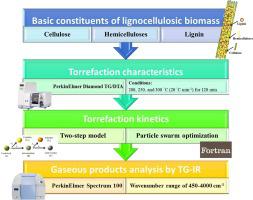Energy Conversion and Management ( IF 10.4 ) Pub Date : 2021-04-24 , DOI: 10.1016/j.enconman.2021.114116 Wei-Hsin Chen , Chun Fong Eng , Yu-Ying Lin , Quang-Vu Bach , Veeramuthu Ashokkumar , Pau-Loke Show

|
The recognition of the isothermal thermodegradation of cellulose, hemicelluloses, and lignin plays a vital role for torrefaction to upgrade lignocellulosic biomass and produce biochar. This study adopts a two-step model with particle swarm optimization (PSO) algorithm to calculate and predict the isothermal torrefaction kinetics of cellulose, hemicelluloses, and lignin under the torrefaction temperatures of 200, 250, and 300 °C. A thermogravimetric analyzer is coupled with Fourier Transform Infrared (TG-FTIR) spectrometer to analyze the instantaneous weight losses and released gaseous products. The predictions suggest that cellulose shows the greatest weight loss and generates the most volatile products (81.70%) followed by a final residue (18.29%) at the isothermal torrefaction temperature of 300 °C. Hemicelluloses have severe weight loss at 250 °C, owing to their relatively weak structure compared to cellulose. The final residue yield is in the range of 60.04–74.05%, and the second prevalent product is the intermediate ranging from 3.34 to 8.20%. Lignin shows higher thermal resistance to torrefaction and produces the most intermediate under the isothermal torrefaction at temperatures lower than 300 °C, accounting for 86.41–97.50%. The activation energies of cellulose, hemicelluloses, and lignin are in the range of 166–260, 48–55, and 59–70 kJ mol−1, respectively. The FTIR spectra indicate that CO and CO2 are the dominant gases in the torrefaction of the three model compounds due to the cleavages of methoxyl, ether, carboxyl, and carbonyl groups.
中文翻译:

粒子群算法分析等温焙烧下纤维素,半纤维素和木质素的两步热降解动力学
纤维素,半纤维素和木质素的等温热降解的认识对于焙烤提高木质纤维素生物质并产生生物炭起着至关重要的作用。本研究采用具有粒子群优化(PSO)算法的两步模型来计算和预测在200、250和300°C的烘烤温度下纤维素,半纤维素和木质素的等温烘烤动力学。热重分析仪与傅立叶变换红外(TG-FTIR)光谱仪结合使用,可以分析瞬时重量损失和释放出的气态产物。这些预测表明,纤维素在300°C的等温焙烧温度下显示出最大的重量损失,并产生最多的挥发性产物(81.70%),然后是最终残留物(18.29%)。由于半纤维素与纤维素相比结构较弱,因此半纤维素在250°C时具有严重的体重减轻。最终残留物收率在60.04-74.05%的范围内,第二种主要产品是中间产品,介于3.34%至8.20%之间。木质素显示出更高的抗干热性,在低于300°C的等温干热条件下产生的中间产物最多,占86.41–97.50%。纤维素,半纤维素和木质素的活化能在166–260、48–55和59–70 kJ mol的范围内 木质素显示出更高的抗干热性,在低于300°C的等温干热条件下产生的中间产物最多,占86.41–97.50%。纤维素,半纤维素和木质素的活化能在166–260、48–55和59–70 kJ mol的范围内 木质素显示出更高的抗干热性,在低于300°C的等温干热条件下产生的中间产物最多,占86.41–97.50%。纤维素,半纤维素和木质素的活化能在166–260、48–55和59–70 kJ mol的范围内-1。FTIR光谱表明,由于甲氧基,醚,羧基和羰基的裂解,在三种模型化合物的焙干中,CO和CO 2是主要气体。



























 京公网安备 11010802027423号
京公网安备 11010802027423号